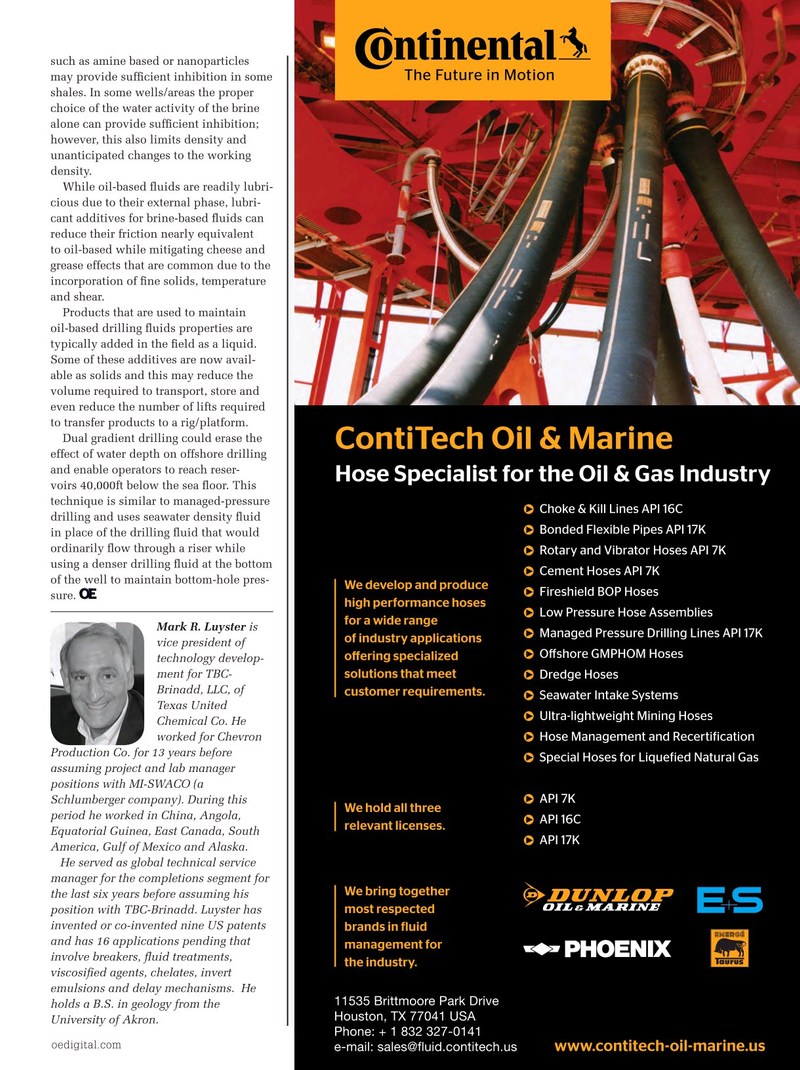
Page 59: of Offshore Engineer Magazine (May/Jun 2015)
Read this page in Pdf, Flash or Html5 edition of May/Jun 2015 Offshore Engineer Magazine
such as amine based or nanoparticles may provide suf? cient inhibition in some shales. In some wells/areas the proper choice of the water activity of the brine alone can provide suf? cient inhibition; however, this also limits density and unanticipated changes to the working density.
While oil-based ? uids are readily lubri- cious due to their external phase, lubri- cant additives for brine-based ? uids can reduce their friction nearly equivalent to oil-based while mitigating cheese and grease effects that are common due to the incorporation of ? ne solids, temperature and shear.
Products that are used to maintain
Fig. 4 – Hydrocarbon soluble solids.
oil-based drilling ? uids properties are
Image courtesy of Patrick Roberts of TBC-Brinadd, LLC.
typically added in the ? eld as a liquid. results in the accumulation of beds that Some of these additives are now avail- interfere when drilling and running able as solids and this may reduce the drillpipe. These beds, if not removed, volume required to transport, store and can potentially plug the lower comple- even reduce the number of lifts required tion assembly (e.g., sand control screen) to transfer products to a rig/platform.
when running to target depth. What Dual gradient drilling could erase the planning teams may request are longer effect of water depth on offshore drilling test periods for simulating static and and enable operators to reach reser- dynamic conditions in the wellbore to voirs 40,000ft below the sea ? oor. This con? rm a ? uid systems’ integrity. There technique is similar to managed-pressure are several mechanisms available to drilling and uses seawater density ? uid mitigate viscosity degradation, however, in place of the drilling ? uid that would some must be carefully addressed as they ordinarily ? ow through a riser while can impact other desired parameters. For using a denser drilling ? uid at the bottom brine-based systems, synthetic viscosi- of the well to maintain bottom-hole pres- ? ers are one option; however, these may sure. impact formation damage. Wellbore temperature changes can also in? uence a Mark R. Luyster is ? uids viscosity such that it is too viscous. vice president of
Systems, especially oil-based, can be technology develop- optimized to maintain viscosity through ment for TBC- the temperature changes from surface Brinadd, LLC, of to sea? oor to the bottom hole whereby Texas United a ? at rheology pro? le is maintained to Chemical Co. He mitigate ? uctuations during dynamic and worked for Chevron static conditions. This alleviates pres- Production Co. for 13 years before sure spikes and progressive gels and aids assuming project and lab manager in controlling the equivalent circulating positions with MI-SWACO (a density (ECD). Schlumberger company). During this
An appropriate ? uid density will period he worked in China, Angola, promote a mechanically stable wellbore Equatorial Guinea, East Canada, South when drilling encounters “soft” shale America, Gulf of Mexico and Alaska. rock however reactive shale minerals can He served as global technical service impart a chemically unstable wellbore. manager for the completions segment for
In the case of the latter the proper choice the last six years before assuming his of base brine and/or additives can help position with TBC-Brinadd. Luyster has alleviate. Upfront planning that includes invented or co-invented nine US patents testing, when whole core is available, and has 16 applications pending that for worst-case static periods can con? rm involve breakers, ? uid treatments, the effectiveness of needed additives. viscosi? ed agents, chelates, invert However, shale rock can be different emulsions and delay mechanisms. He from area to area thus a ? uid system may holds a B.S. in geology from the require customizing. Soluble additives University of Akron.
oedigital.com 056_OE0515_D&C2_TexasBrine.indd 61 4/21/15 9:25 AM
Continental_OE_AD_125_413x276_225mm_out.indd 1 4/8/15 6:18 PM

 58
58

 60
60